| Above: A solar halo appears through cirrus clouds close to midnight at Concordia Station on December 16, 2019. In the foreground are two permanent tents used to store equipment and house overflow residents when the main station is at maximum capacity. (All photos by Pete Akers unless otherwise noted.) |
Editor's note: Paleoclimate researcher Pete Akers (Institut des Géosciences de l’Enivironnement or IGE in Grenoble, France) is a participant in the 2019-20 East Antarctic International Ice Sheet Traverse (Project EAIIST). Pete is writing about the project in a special series for Category 6. See his Cat 6 contributor page for links to previous entries.
The EAIIST traverse embarked from Concordia Station on its official mission to travel to the Megadunes site on December 7, 2019. Due to some difficulties with one of our primary ice coring devices, we did some last-minute personnel shifts to make sure that our coring expert would be present on the first leg of the traverse. This way, we would be assured that we would successfully get our critically important ice cores from this initial phase. To make room for our coring expert, and with a space open on the second leg of the traverse (the return from the Megadunes to Concordia), I swapped my role from the first leg to the second leg. The second leg began with a flight to the Megadunes site on January 3 to rejoin the EAIIST caravan.
In the meantime, I stayed at Concordia station and helped with snow chemistry experiments and sampling projects, including joining an ambitious snow trench study. The time spent here at Concordia was great for getting to know the people and culture of the research station, which has been permanently staffed since 2005. Although every station is different, my experiences here over roughly a month and at the stations leading up to this point can hopefully shed some light on what it is like to spend some time in an Antarctic base.
 |
| Figure 1. The EAIIST traverse leaves Concordia station on December 7 on route to the Megadunes site. It took three weeks to reach the site 400 miles (650 km) away, with multiple multi-day stops for research and sampling along the way. |
Research station basics
Antarctica is currently host to dozens of research stations run by programs from around 30 countries. Although a few countries have made territorial claims to Antarctica, no country is recognized internationally as having ownership to the continent. Instead, it is governed under the Antarctic Treaty, which was signed in 1961. This treaty outlines Antarctica as a place reserved purely for peaceful and scientific work; military members and equipment can be used to assist research purposes, but any projection of military power (like building a military base or testing weapons) is prohibited. Later agreements have restricted possible mining and mineral extraction and focused on reducing environmental harms such as polluting the landscape and disturbing animals.
Most of the Antarctic stations are built on rocky outcrops along the coasts. While there is plenty of solid ice on which the stations could theoretically be placed, building structures on glacial ice is very difficult: the ice moves and distorts under the buildings while new snowfall gradually buries the station from above. The few stations built on the ice sheets themselves are usually built up at higher ice-sheet elevations, such as here at Concordia, where the ice movement and snowfall rate are much less than places closer to the coasts. Still, even structures this far inland will eventually be buried in the ice. Newer station designs include elevated and modular buildings that allow some level of adaptation to the steadily accumulating snow.
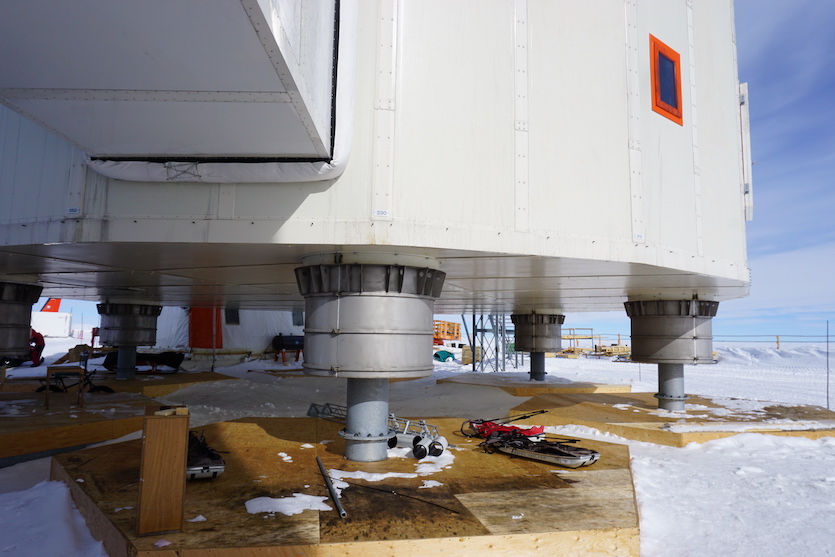 |
| Figure 2. Concordia’s elevated supports that allow wind and drifting snow to pass under the towers rather than piling up and eventually burying the structures. |
Stations in Antarctica vary wildly in size from minor summer stations with only a couple of buildings and a dozen personnel to the mini-city that is the American McMurdo station, which can host over 1000 people at its peak population in summer. Contrary to general public perception of these stations, research scientists only make up a small fraction of any station’s staffing: most people in Antarctica are mechanics, cooks, plumbers, and other support staff who perform the critical work needed to keep the stations and science missions running.
Many stations also have a sizeable dedicated fire department, since a fire in an Antarctic station would be incredibly dangerous due to concentrated fuels and structures, strong winds, dry air, and the lack of subsequent shelter or a speedy evacuation for people after a fire.
General life at a station varies widely from place to place, but most have a fairly consistent daily work schedule anchored by meals in a common space. Meal times are taken seriously as a chance to socialize and take much-deserved breaks from work and the harsh weather. Knowing the effect that a good meal can have on morale in such an isolating place, cooks (at least at the French and Italian bases) are often quite skilled and whip up two- and three-course meals—a far cry from the military-style rations many people envision for Antarctic work. Internet access is typically very limited, and open use is usually available only at a few public computers.
Each station has its own culture, developed through the local environment, station history, and common shared experiences among its isolated members. Mementos of past projects and station members are scattered throughout the stations like relics, adding a bit of human touch to the otherwise stark environment.
 |
| Figure 3. Some of the wall decorations in Concordia’s dining space, with each piece naming the members of a previous overwintering team. |
New arrivals to a station are given a briefing on local station rules and environmental policies. Travel outside a very short distance from stations is generally not allowed unless for specific missions and may require some degree of survival training. This restriction is for several purposes: to reduce human impact on the Antarctic environment, to limit possibilities of serious accidents, and to keep specific zones pristine for scientific study. A minimum of a 15 ft (5 m) distance is maintained from all wildlife, with more distance from breeding animals, and no waste is to be left out in the wild. This includes human waste: the coastal Italian Mario Zucchelli station, for example, has dedicated “pee bottles” that you must check out for longer field trips!
Trash at the stations is sorted by type, with paper and organics often incinerated locally and other refuse shipped back to other countries for recycling or dumping. Wastewater at the larger stations is typically treated before release into the ocean. Concordia and other remote inland stations have sophisticated water recycling and waste systems to limit environmental impact and the need for costly trash export.
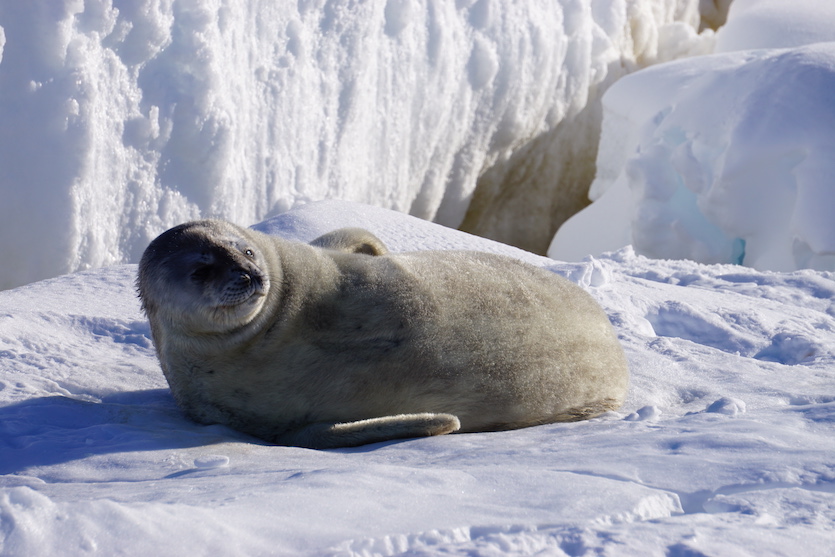 |
| Figure 4. A good zoom lens is needed to get close-up photos of animals (such as this Weddell seal resting on sea ice near Dumont d’Urville station) without violating the minimum distance rules. Human impact on the local environment is to be limited as much as possible according to the Antarctic Treaty. |
Becoming a station resident
For the researchers and technical workers who decide to call the continent home for a time, the process begins months before the actual arrival. Most of the research and other work occurs during the brief Southern Hemisphere summer season from November to February, when weather conditions are relatively good and flights/shipping are possible continent-wide.
The brutally cold conditions and travel difficulty in winter means that many of the scientific stations in Antarctica are occupied only in the summer. The few all-year stations dramatically cut staff to minimum levels during winter, and these “winter-over” members cannot leave their stations for months while travel is not possible. Concordia, for example, has 13 people who winter over, consisting of 5 scientists, 8 technical staff, a doctor, and a chef. Due to the mental stress of being isolated in 24-hour darkness for months, winter-over applicants must pass psychological exams as well as medical tests prior to starting their position.
It’s not just those coming for a winter-over who are scrutinized for Antarctic work: any person going to Antarctica for more than just a tourist cruise must pass a series of extensive medical tests to prove that they are healthy enough to handle the rigors of the environment. Many tests are designed to catch potential critical medical problems that can be especially life-threatening when hospital-level care is potentially a day or more away (assuming that a medivac flight can even be arranged that quickly). These tests include cardio checks, a full dental exam, chest X-rays, and about every blood test you can think of. These blood tests are not only to check your physical health: with limited numbers of people at any location in Antarctica, each member of an expedition is expected to serve as a blood donor should the need arise, and your blood type must be readily available.
Even with all these precautions, problems still occur, and each station is well-stocked with medical equipment and one or more medical staff. You may recall the story of Jerri Nielsen, an American physicianwho was a winter-over member at the Amundsen-Scott South Pole Station in 1998, when she developed breast cancer. A plane couldn’t land to evacuate her due to the darkness and cold temperatures, so medical supplies were airdropped in the middle of the frigid polar winter. She performed a biopsy and initiated chemotherapy until an early flight could eventually land three months later.
Our EAIIST traverse includes medic as well as a cabinet fully stocked with basic medical supplies plus splints, defibrillators, and oxygen respirators should a problem arise while on our mission. Concordia Station has its own medical facility complete with X-ray and dental capabilities, and most larger stations have similar medical infrastructure.
Concordia Station infrastructure
As a relatively new station that opened in 2005, Concordia is quite spacious, comfortable, and well equipped for science. Two towers, each with three levels, form the bulk of the station, with one tower for living quarters, communications, and science labs, and the other tower for recreation and dining. Much of the ground floor of the station is taken up by the medical facility and machine shops. Outside the station, you will find a flattened parking space for traverse caravans, a plowed snow landing strip for planes, and several smaller science structures located within a half-mile (1 km) radius.
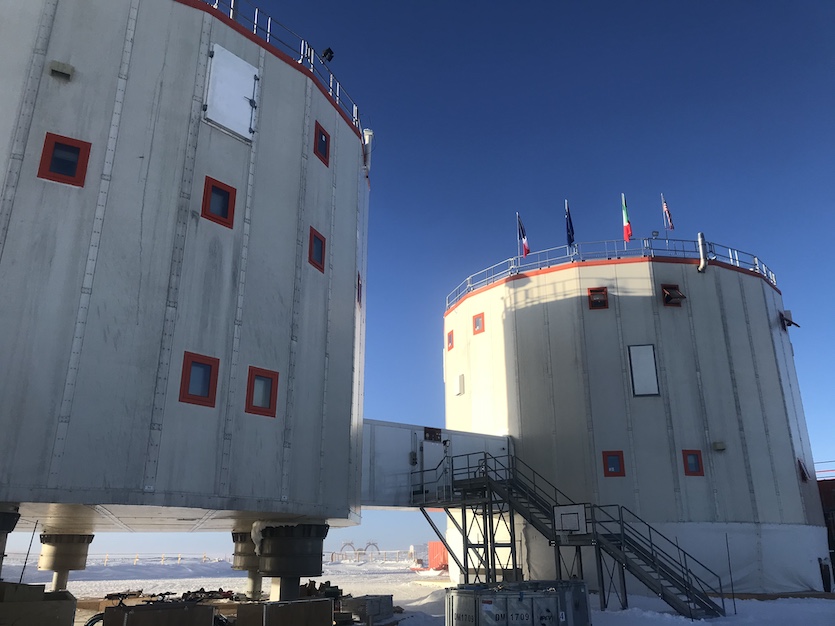 |
| Figure 5. The two main towers of Concordia Station. |
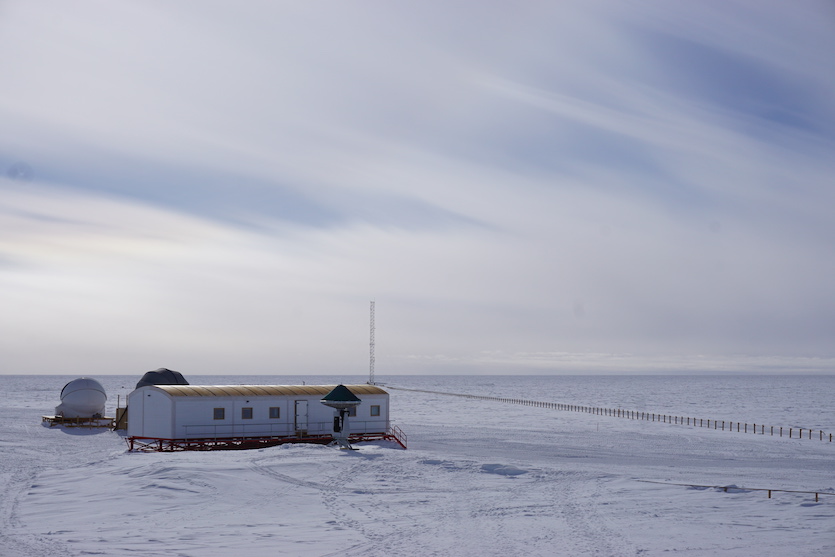 |
| Figure 6. Some of the astronomical stations and telescopes at Dome C, with a meteorological and atmospheric sampling tower in the background. The fence-like structure is the support for power and communication cables that link to the main station. |
Prior to the construction of the year-round main Concordia, other structures had been built at Dome C in the 1990s for summer-only research work. These older buildings are referred to as the “summer camp” portion of Concordia, and they were originally the living and support base for members for the European Project for Ice Coring in Antarctica (EPICA) who were drilling the Dome C ice core. Today, they provide workspace and extra housing for the expanded summer research population that cannot all be housed in the main station.
Concordia’s summer population is usually around 60 but in constant flux, with arrivals and departures roughly once a week through the small planes that provide inter-station transit across Antarctica. Most of the summer technical and support staff arrive in early November and stay through February. Scientists generally come and stay for only part of the summer season (a few weeks to over a month), though some projects require longer stays that last nearly the whole season. During summer, people sleep two to a room in the station and summer camp, and high populations require opening some sleeping tents that date to the EPICA drilling days. While a “tent in Antarctica” may not sound very appealing, these tents are actually quite cozy, comfortable, and spacious. I can speak to this from experience: I spent almost a month at Concordia staying in a tent.
 |
| Figure 7. The summer camp of Concordia, originally built in the 1990s to support the drilling activities at Dome C. |
 |
| Figure 8. Comfortable lodging in one of the Concordia tents. Heat is provided by the iron oil-burning heater at back, and a warm temperature is easily maintained in the well-insulated tent. |
Movement outside the station to the summer camp or to nearby science outposts is by foot or, after a brief training, snowmobile. During the workday, the area around the main station hums with the activity of researchers arriving and departing, workers rapidly constructing new structures, and supplies being moved to and from storage containers. Work days are somewhat long, lasting from the post-breakfast daily briefing at 8:00 a.m. to dinner at 7:00 p.m., with a lengthy lunch break. Saturdays are also standard work days, with most station members taking Sunday as a rest. However, some work like daily snow and atmospheric measurements must still be performed even on Sundays. This intense work schedule is due to the limitations of the Antarctic environment: all major work needed for the year must be completed in the 3.5-month summer.
By the end of February, all vehicles will be mothballed until November, staff will be down to only the winter-over crew of 13, and work will be limited to scientific observations and basic maintenance to keep the station running until November. Meanwhile, the sun will sink below the horizon from May until August and temperatures will plummet, at times approaching –110°F (–80°C).
The environment of Dome C
At 75°S and over 10,600 ft (3233 m) in elevation, Concordia is constantly frigid, even with 24 hours of sunlight in summer. For most places on Earth, the warmest temperatures of the year are a month or more after the summer solstice due to the lagged warming of oceans and exposed land. However, there is only highly reflective and insulating snow at Concordia, so the warmest part of the year occurs very shortly after the solstice in December when solar radiation is highest. Here at Concordia, this “warm peak” occurred during my stay, but it meant temperatures ranging between 0°F and –30°F (–20°C and –35°C).
Winds are typically light, as our location at a high point on the ice sheet means that gravity-powered katabatic winds are limited. Still, with such cold conditions even a light wind can produce dangerous wind chills: the wind chill during my time here has gotten as low as –58°F (–50°C) despite the wind being only about 5-10 mph (2-4 m/s). Air pressure is low due to the altitude (usually 650-660 hPa) and altitude sickness is common for new arrivals. Luckily for me and the other members of EAIIST who were on the science traverse from Dumont d’Urville Station, our slow ascent to Concordia meant we suffered only from shortness of breath in the thin air.
Conditions at Dome C are clear and sunny almost every day, as moist air masses find it difficult to reach so far inland and high up. While coastal storms raged with wind and snow at Dumont d’Urville and Mario Zucchelli stations, we could hardly notice other than the occasional cloud bank observed far on the horizon. What moisture does arrive at Dome C often comes in the form of diamond dust (ground-level ice crystal clouds) and high cirrus clouds. While these clouds don’t produce much precipitation (annual snowfall is only around 1-3 in or 3-8 cm), they often produce solar halos. In one spectacular event on December 10, some elevated ice crystal clouds produced a complex of halo effects, including a Parry arc above the sun, a 360° ring around the sky, and Wegener arcs that angled to cross the 360° ring at a point directly opposite the sun. This display lasted less than half an hour total, but it made an impression on even the most seasoned Antarctic residents at the station.
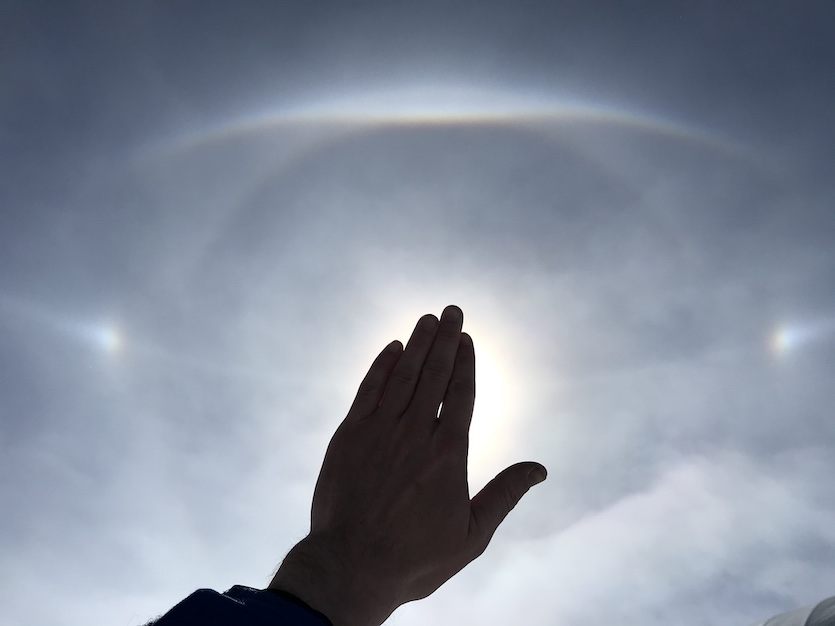 |
| Figure 9. Complex solar halo effects observed at Concordia on December 10, 2019. |
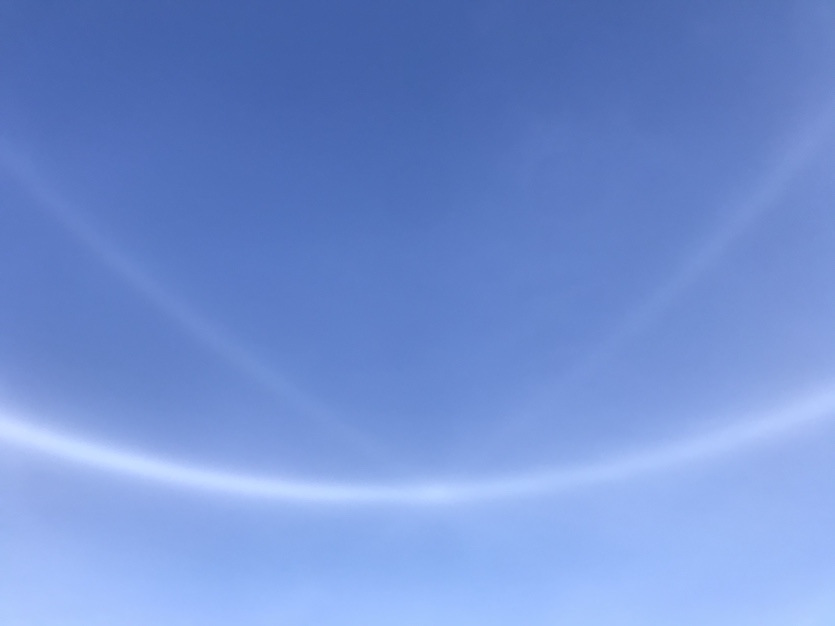 |
| Figure 10. The view in the sky opposite the sun during the event in Figure 9 shows a complete 360° horizontal arc and two Wegener arcs crossing at the exact opposite point from the sun. Having a permanent, year-round station in Antarctica is difficult and expensive, but it offers stability and accumulated experience that pays massive dividends in terms of science. In my next post, I’ll cover some of the various scientific endeavors at Concordia, including my personal snow trench sampling project and the remarkable ice core drilling efforts that changed our understanding of Earth’s climate history. |




